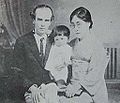List
| Picture | Name | Dates | Nationality | Significant contributions |
|---|---|---|---|---|
 | Arakawa Shintarō 荒川慎太郎 | b. 1971 | Japan | "Tangut Rhyme Dictionary" (1997) Tangut-Russian-English-Chinese Dictionary (2006) |
| Bái Bīn 白濱 [1] | 1936–2022 | China | Study of the Sea of Characters (1983) Researches in Tangut History (1989) | |
 | Mathieu Beaudouin | b. 1989 | France | "Tangut and Horpa languages: Some morphosyntactic shared features" (2023) [2] Grammaire du tangoute. Phonologie et morphologie. PhD dissertation. (2023) [3] "Non-past and past verb stems in Tangut" (2024) [4] |
 | Anna Bernhardi | 1868–1944 | Germany | "Buddhistische Bilder aus der Glanzzeit der Tanguten" (1918) |
 | Stephen Wootton Bushell | 1844–1908 | UK | "The Hsi Hsia Dynasty of Tangut, their Money and Peculiar Script" (1895–1896) "The Tangut script in the Nan K'ou Pass" (1899) |
| Gerard Clauson [5] | 1891–1974 | UK | Skeleton Dictionary of the Hsi-Hsia Language (1938–1963, manuscript published posthumously in 2016 [6] ) | |
 | Gabriel Devéria | 1844–1899 | France | "L'Écriture du Royaume de Si-Hia ou Tangout" (1898) "Stèle Si-hia de Leang-tcheou" (1898) [7] |
| Ruth W. Dunnell | b. 1950 | US | "The 1094 Sino-Tangut Gantong Stupa Stele Inscription of Wuwei" (1988) The Great State of White and High: Buddhism and State Formation in Eleventh-Century Xia (1996) | |
 | Imre Galambos [8] | b. 1967 | Hungary | "The Tangut translation of the General's Garden by Zhuge Liang" (2011) Translating Chinese Tradition and Teaching Tangut Culture (2015) |
| Gong Hwang-cherng (Gōng Huángchéng) 龔煌城 | 1934–2010 | Taiwan | "The phonological reconstruction of Tangut through examination of phonological alternations" (1989) | |
 | Gōng Xūn 龔勳 | b. 1990 | China | "Uvulars and uvularization in Tangut phonology" (2020) [9] |
| Eric Grinstead | 1921–2008 | New Zealand | The Tangut Tripitaka (1971) Analysis of the Tangut Script (1972) | |
 | Hán Xiǎománg 韓小忙 [10] | b. 1963 | China | Dictionary of Tangut 西夏文词典 [9 vols.] (2021) |
| Huáng Zhènhuá 黃振華 [11] | 1930–2003 | China | Study of the Sea of Characters (1983) Researches in Tangut History (1989) | |
| Aleksei Ivanovich Ivanov Алексе́й Ива́нович Ивано́в | 1878–1937 | Russia | "Monuments de l'écriture tangout" (1920) | |
 | Guillaume Jacques | b. 1979 | France | "The origin of vowel alternations in the Tangut verb" (2009) "The structure of the Tangut verb" (2011) Esquisse de phonologie et de morphologie historique du tangoute (2014) |
 | Jiǎ Chángyè 賈常業 [12] | b. 1954 | China | Newly Compiled Dictionary of Tangut Characters (2013) |
 | Jǐng Yǒngshí 景永時 [13] | b. 1959 | China | Translations of books and articles by Russian Tangutologists Design of Tangut fonts |
 | Ksenia Borisovna Kepping Ксе́ния Бори́совна Ке́пинг [14] | 1937–2002 | Russia | Sea of Characters (1969) Sunzi in Tangut translation (1979) Morphology of the Tangut Language (1985) "Tangut Ritual Language" (1996) |
| Vsevolod Sergeevich Kolokolov Все́волод Серге́евич Ко́локолов [15] | 1896–1979 | Russia | Chinese Classics in Tangut Translation (1966) Sea of Characters (1969) | |
| Luc Kwanten | 1944–2021 | Belgium | The Timely Pearl: A 12th Century Tangut-Chinese Glossary (1982) "The Phonological hypothesis of the Hsi Hsia [Tangut] Language," (1984) "Special Research Problems in Hsi Hsia [Tangut] History and Linguistics" (1985) "The Structure of the Tangut [Hsi Hsia] characters" (1989) | |
 | Evgenij Ivanovich Kychanov Евге́ний Ива́нович Кыча́нов [16] | 1932–2013 | Russia | Chinese Classics in Tangut Translation (1966) Essay on the History of the Tangut State (1968) Sea of Characters (1969) Tangut-Russian-English-Chinese Dictionary' (2006) |
 | Romain Lefebvre [8] | b. 1981 | France | L'imaginaire de l'autre : Étude et analyse de la réception du volume 41 de l'Avataṃsakasūtra en langue tangoute, conservé à l'Université de Pékin et à l'Institut des hautes études chinoises du Collège de France (2013) |
| Lǐ Fànwén 李範文 [17] | b. 1932 | China | Study of the Homophones (1986) Tangut-Chinese Dictionary (1997, 2008) | |
 | Lin Ying-chin (Lín Yīngjīn) 林英津 [18] | b. 1955 | Taiwan | Study of the Tangut translation of "Sunzi's Art of War" (1994) |
 | Luó Zhènyù 羅振玉 [19] | 1866–1940 | China | Collection of Western Xia Official Seals (1927) |
 | Luó Fúchéng 羅福成 [20] | 1885–1960 | China | Study of the Lotus Sutra in Tangut (1914) |
 | Luó Fúcháng 羅福萇 [21] | 1895–1921 | China | Brief Explanation of the Western Xia Script (1914) |
| Luó Fúyí 羅福頤 [22] | 1905–1981 | China | Collected Study of Official Seals of the Western Xia (1982) | |
 | Marc Miyake [8] | b. 1971 | US | "Sketch of Pre-Tangut" (2012) |
| Georges Morisse | d. 1910 | France | "Contribution préliminaire à l'étude de l'écriture et de la langue si-hia" (1904) — study of the Tangut translation of the Saddharma Puṇḍarīka ( Lotus Sutra ). [23] | |
 | Nikolai Aleksandrovich Nevsky Никола́й Алекса́ндрович Не́вский [24] | 1892–1937 | Russia | "A Brief Manual of the Si-Hia Characters with Tibetan Transcriptions" (1926) Tangut Philology (1960) |
 | Niè Hóngyīn 聶鴻音 [25] | b. 1954 | China | "Study of the phonetic symbols used in the Pearl in the Palm" (1987) "Tangutology During the Past Decades" (1993) |
 | Nishida Tatsuo 西田龍雄 [26] | 1928–2012 | Japan | Study of the Hsi-Hsia Language (1964) Language and Culture of the Tangut Kingdom (1997) |
| Niú Dáshēng 牛达生 [27] | b. 1933 | China | The Western Xia Square Pagoda at Baisigou (2005) Research into Western Xia Coins (2013) | |
 | Shǐ Jīnbō 史金波 [28] | b. 1940 | China | Study of the Sea of Characters (1983) Brief History of Buddhism in the Western Xia (1988) Study of Western Xia Publishing (2004) Tangut Language and Manuscripts: An Introduction 西夏文教程 (2013, English edition 2020) The Economy of Western Xia: A Study of 11th to 13th Century Tangut Records 西夏经济文书研究 (2017, English edition 2021) |
| Mikhail Viktorovich Sofronov Михаи́л Ви́кторович Софро́нов [29] | b. 1929 | Russia | Grammar of the Tangut Language (1968) | |
 | Kirill Iurʹevich Solonin Кири́лл Ю́рьевич Соло́нин [30] | b. 1969 | Russia | "Hongzhou Buddhism in Xixia and the Heritage of Zongmi (780–841)" (2003) "The Chan Teaching of Nanyang Huizhong (?-775) in Tangut Translation" (2012) "The "Perfect Teaching" and Liao Sources of Tangut Chan Buddhism: A Study of Jiexing zhaoxin tu" (2013) |
 | Sūn Bójūn 孫伯君 [31] | b. 1966 | China | "Sanskrit-Chinese phonetic transcriptions and the Northwest Chinese dialect in Tangut translations of sūtras" (2007) |
 | Tai Chung-pui 戴忠沛 [32] | b. 1977 | China (Hong Kong) | "Collation of five newly seen Tangut fragments with Tibetan transcription" (2009) |
| Anatoly Pavlovich Terentev-Katansky Анато́лий Па́влович Тере́нтьев-Ката́нский [33] | 1934–1998 | Russia | Book Publishing in the Tangut State (1981) Sea of Characters (1969) | |
 | Wáng Jìngrú 王静如 [34] | 1903–1990 | China | "Notes on the Chinese and Tibetan transcriptions of the Hsi-hsia (Tangutan) language" (1930) Research on the Western Xia (1933) "Introduction to the Phonetic System of the Tangut Language" (1982) |
 | Andrew West [35] | 1960–2025 | UK | 2012. "Musical Notation for Flute in Tangut Manuscripts". In Irina Fedorovna Popova (ed.), Тангуты в Центральной Азии: сборник статей в честь 80-летия проф. Е.И.Кычанова [Tanguts in Central Asia: a collection of articles marking the 80th anniversary of Prof. E. I. Kychanov] pp. 443–453. Moscow: Oriental Literature. ISBN 978-5-02-036505-6 2016. Gerard Clauson's Skeleton Tangut (Hsi Hsia) Dictionary: A facsimile edition. With an introduction by Imre Galambos. With Editorial notes and an Index by Andrew West. Prepared for publication by Michael Everson. Portlaoise: Evertype. ISBN 978-1-78201-167-5. |
| Stuart N. Wolfenden | 1889–1938 | US | "On the Tibetan Transcription of Si-Hia Words" (1931) "On the Prefixes and Consonantal Finals of Si-Hia as evidenced by their Chinese and Tibetan transcriptions" (1934) | |
| Viacheslav Petrovich Zaytsev Вячесла́в Петро́вич За́йцев [36] | b. 1976 | Russia | "Re-examination of the Tangut Fragment Or. 12380/3495 from the Collection of the British Library" (2016) | |